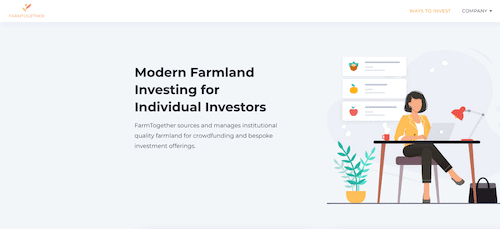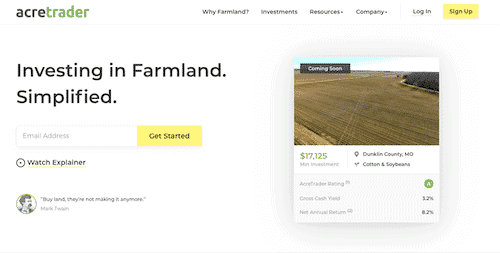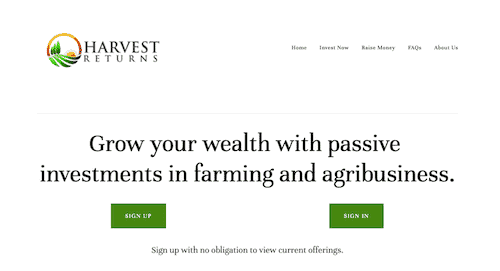Have you ever thought about investing in farmland?
Don’t worry — you do not need to become a farmer or worry about growing and maintaining crops, or take care of livestock.
But as you probably know, diversifying your investment portfolio is one of the smartest things you can do when you start putting your money to work.
And expanding into agriculture could be another great way to grow your wealth and portfolio.
So how do you invest in farmland? What options do you have? And what are the pros and cons of farmland and agriculture investing? You’ll learn it all in this guide.
Why Farmland?
You might be surprised to find out, that farmland is one of the more stable investments out there and is an interesting part of real estate that many investors don’t always think about.
According to Forbes, farmland represents a nearly $9 trillion market globally and has historically high returns. And for the past 47 years, U.S. farmland for example has yielded returns of over 10%!
Not too shabby, amirite?
One example provided by AcreTrader calculations from data by NCREIF, Bloomberg, and Bankrate, found that just $10,000 invested in farmland in 1990 would be worth over $199,700 today.
Additionally, the amount of farmland is limited in the U.S. but the demand is always there. After all, agriculture is important to feed people and animals, for alternative fuels, and other necessary resources.
And farmland has a very low correlation to what the stock market or traditional real estate market is doing. Therefore, it can be a great way to diversify and hedge against volatility in other markets.
Now investing in farmland is not perfect and there are risks like with any investment, but more on that in the pros and cons section further down.
How Can I Invest in Farmland?
Fortunately, you have a few ways to start investing in farmland. You can mix up the assets that tie into the agriculture industry or you can focus on investing in land directly. What you decide to do will be dependent on your personal finance goals and risk tolerance.
But here are the common ways to start investing in farmland and agriculture today.
Buy Farmland Directly
The most obvious way to invest in farmland and agriculture is to just buy a farm directly. Of course, that thought is much easier than actually going through the process of investing in farmland.
But if this a route you want to go, it can be a great option. Plus, you don’t need to be a farmer to own a farm and you can still generate returns from your investment.
It works pretty much like investing in regular real estate. If you have the capital and means, you can buy farmland directly which you rent out to farmers looking to grow crops and tend to livestock.
It can be a win-win for both sides because:
- As an investor, you can pay down your loan on the property, build equity, and generate some income when you rent out the farm. Additionally, over time your land should appreciate in value too.
- For the farmer, they can run their farm business and make money without having to purchase the land or have a large sum of money for the property. Instead, they’ll pay the landlord (you) per month for the property.
Crowdfunding
The crowdfunding market has grown significantly in the last few years, especially in the U.S. as regulations have changed for investors. You can invest in real estate via Fundrise or DiversyFund, invest in fine art with Masterworks, and now farmland.
The beauty of crowdfunding is being able to invest with less money and dealing with fewer logistics.
There are certainly some pros and cons going in this direction, but it can be a great way to get started investing in agriculture, without risking too much capital.
Here are a few farmland crowdfunding platforms to consider:
FarmTogether

One of the more popular farmlands investing platforms is FarmTogether. The company sources and manages institutional quality farmland for crowdfunding and all its investment offerings. These investments are for the long-term, with a horizon of 5+ years.
Additionally, their minimum investments start at $10,000. And FarmTogether offers individual investors who seek sole ownership and are willing to invest $1,000,000+ in equity per farm options as well.
You can invest in self-directed IRAs, Solo 401k accounts, corporations, LLCs, and other vehicles. But the downside is you will need to be an accredited investor to get started with FarmTogether.
AcreTrader

Another popular farmland crowdfunding platform is AcreTrader, which is also only open to accredited investors at this time. But similar to FarmTogether, the AcreTrader platform only selects roughly 1% of assets for their investors, ensuring top quality.
When you see an investment you like, you can get your shares of the farmland. AcreTrade handles all the management (accounting, insurance, working with farmers, etc.) and investors receive annual income from your shares.
The minimum investments vary, but from some of their recently closed deals, they’ve ranged from $15,000 to over $30,000. So this is quite a bit of cash to get started.
Harvest Returns

Like the other crowdfunding platforms, Harvest Returns lets you invest in various agricultural investments.
But the big difference here is that they’ll have investments for both accredited and non-accredited investors. This gives more people a chance to get a piece of the farmland pie!
These investments are vetted by the Harvest Returns team and they only select the top choices. As an investor, you can expect to find deals where minimum investments will vary from $5,000 up to $25,000. And you can also invest in their offerings with a self-directed IRA.
Investing in Farm Debt
According to the USDA, farm debt is forecast to increase by $9.6 billion (2.2 percent) to $441.7 billion (in nominal terms), led by an expected 3.1% rise in real estate debt.
While the debt might be rising, that gives you as an investor a new opportunity. Instead of buying farmland directly or using crowdfunding, you can explore lending money to farmers.
Since the cost of running a farm and equipment requires a lot of capital, farmers tend to take on quite a bit of debt each year. This can require that farmers take on loans to make any new purchases for the upcoming farming season.
So as an investor you can purchase farm debt directly or through bonds, which then provide you with consistent payments that the borrower pays back with interest in a given period of time.
When you buy the debt, there is a risk of default. But if you found a trustworthy farm that consistently pays its bills, you’ll find that investing in farm debt could be a good opportunity.
Real Estate Investment Trusts (REITs)
A REIT is a group of companies that will collect money from different portfolios of real estate. Typically you can find REITs in the investment company where you invest in stocks and bonds.
But there are also REITs that are related to farming that you can invest in as well.
The good thing about farming REITs is that they are much less expensive to purchase and diversify your portfolio. Plus, they offer solid dividend returns as they are required by the law to return profits to their shareholders.
So if you aren’t an accredited investor or can’t afford to buy land, farming REITs are solid income-producing assets that might be worth adding to your portfolio.
Two farmland REITs to consider:
- Gladstone Land Corporation (NYSE: LAND). The company currently owns 127 farms, with over 90,000 acres of land in 13 different states.
- Farmland Partners Inc. (NYSE: FPI). The company has over 150,000 acres of land in 16 states.
However, remember these REITs tend to follow the stock market trends, so you are not as diversified as buying land direct and debt, or shares in crowdfunding.
Mutual Funds and ETFs
Although you might not be investing in farmland directly here, you are investing in agriculture and related companies that may own farms. This makes mutual funds and ETFs another interesting investment opportunity for you.
Instead of investing in individual companies, investing in mutual funds or ETFs gets you diversified in a blend of companies that are related to farming, agriculture, and commodities.
Remember, there typically fees when you invest in these assets and it will follow the volatility of the stock market.
Three Examples:
- Invesco DB Agriculture Fund
- iShares Global Agriculture Index ETF
- Teucrium Soybean Fund
If you are looking for more ETFs in the commodity space, here’s a list that has all the various funds in this category. Also, if you are using the awesome platform M1 Finance, they offer some farm-related ETFs that might interest you.
Buy Equities
The last option to help you invest in farmland is through equities or owning shares of companies that are publicly traded on the stock market.
Individual stock investing is always a bit riskier than mutual funds or ETFs because it involved researching and finding the right companies to invest with.
There are plenty of companies that are in the agriculture and commodities space, which many also own various farms related to the business overall. And this is another way to get involved in the farming industry, without directly owning the land or needing large upfront capital.
If you decided to invest in equities around farming, you’ll find organizations in categories like:
- Crop production (Ex. Fresh Del Monte Produce, NYSE: FDP)
- Fertilizer companies (Ex. Scotts Miracle-Gro Company, NYSE: SMG)
- Transportation companies (Ex. Deere and Company, NYSE: DE)
- Seed manufacturers (Ex. DuPont, NYSE: DD)
- Food distributors (Ex. Tyson Foods, NYSE: TSN)
Is Farmland a Good Investment?
Farmland can be a good investment as it helps you diversify your portfolio and it has little to no correlation with inflation or the stock market movements. An investor can make money in multiple ways and has various options to generate income. But there are also risks, just like any investment.
To help you understand if farmland and agriculture are good investments, below are some of the common pros and cons.
Pros
People always need to eat
Farming is not going away as people rely on farms for food. And as the population grows, it’s a safe bet that farms will continue to be important in the future.
Farms continue to be productive
The output of farms continues to grow and many farmers need less land to accomplish more. That has a lot to do with technology and advances in science that make farming more productive than ever.
Multiple ways to make returns on your money
Investing in farmland creates a few opportunities to make money, pending how you plan to invest. Buying farmland directly lets you make money renting to farmers and growing appreciating in the property, for example.
Diversified from the stock market and real estate
As mentioned earlier in this post, when you invest in farmland you are diversifying away from the traditional real estate market and the stock market. Unless you do invest in mutual funds or ETFs, your farm investment will have little correlation to those markets.
Cons
Climate can affect farming results
One factor that is out of anyone’s control is the effect of the climate and weather on farmland. Too much rain, sun, or unprecedented cold fronts or heat waves could ruin the land or crops. And this can be impactful on farms across the globe, not just in the U.S.
Trade war politics
While I’m no fan of politics, it can also affect the agriculture and farming industries. When there are different regulations in place on which countries can trade, it impacts business overall. Farms face the same challenges as other industries if certain countries are in a “trade war” with the U.S. Something to be mindful of when investing in farmland.
Farmland is not very liquid
Investing in farmland or owning shares of farms is typically not a very liquid investment. Meaning, it may not be easily sold if you need the money sooner than later. Generally, your money in farmland should be a long-term investment of 3-5+ years.
Now with ETFs or mutual funds, these assets can be sold quickly since they are trading through the stock exchanges.
When Does It Make Sense To Invest In Farmland?
If you are ready to invest in farmland, it’s important to remember that you will need plenty of upfront capital and should be an accredited investor.
Whether that is investing in farms directly, taking on farm debt, or participating in farmland crowdfunding — a higher net worth will matter.
But if you are accredited and looking to diversify your portfolio, farmland and agriculture investments certainly could be an interesting option. It might be good to start with something like FarmTogether, which has less risk than buying a farm directly and the minimum investments are more affordable.
However, you can also dabble in agriculture and farming through the stock market with less upfront cash and you do not need to be accredited. Anyone can invest in ETFs or mutual funds that fit into the farming category.
But what you decide to do depends on your finances, risk tolerance, and overall financial goals.
